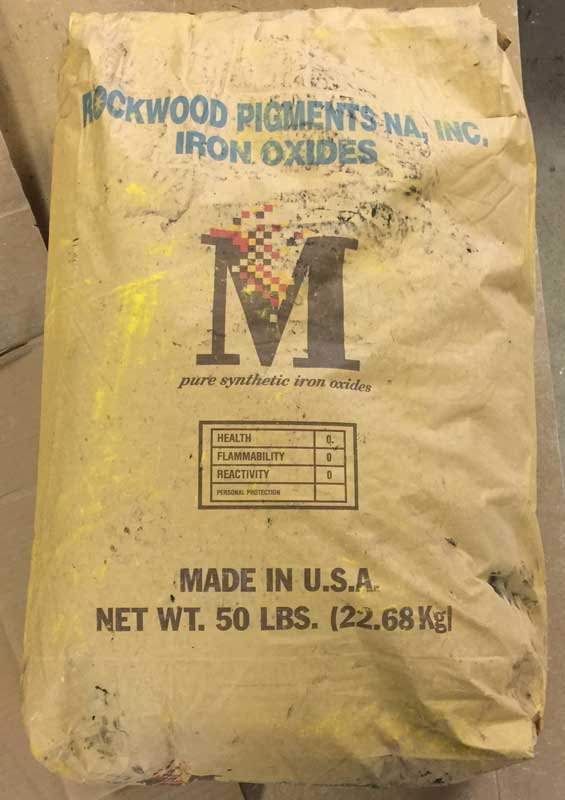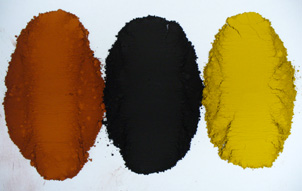| Monthly Tech-Tip | No tracking! No ads! | |
Iron Oxide Yellow
Alternate Names: Iron(III) oxide, hydrated iron oxide, iron(III) hydroxide, yellow iron oxide
Description: FeO(OH).H2O, Fe(OH)3, Goethite
| Oxide | Analysis | Formula | Tolerance |
|---|---|---|---|
| Fe2O3 | 88.00% | 1.00 | |
| LOI | 12.00% | n/a | |
| Oxide Weight | 160.00 | ||
| Formula Weight | 181.82 | ||
Notes
This is one of the many raw colors of iron oxide powder. It is an iron hydroxide. Yellow ochre clay contains yellow iron oxide. In ceramics, red iron oxide is most commonly used in glazes and clay bodies, but black is also used. Yellow is the least color-stable form. Yellow iron oxide is a synthetic material of very fine particle size (but not as fine as black or red). All forms of iron normally produce red coloration when fired in clay bodies in oxidation.
Actual yellow iron oxides are around 85% Fe2O3 and about 12% LOI with some impurities (e.g. SiO2, CaO).
Theoretically, any form of iron could be used to source Fe in the fired ceramic product (of course they lose different amounts of volatiles on firing so they cannot be substituted gram-for-gram). However, in practice, this is not the case. Yellow iron, in our tests, for example, does not stain a glaze but it does stain a clay body. The reason is not apparent.
Yellow iron is not as fluffy and light as black, but more than red. It does not agglomerate as badly as red, but more than black. It is coarser in particle size and can leave some lighter colored residue on a 325 mesh screen (up to 8% in one specimen we tested whereas the others left zero).
Like other forms of iron, this is never used pure, it is always part of a recipe (a glaze, engobe or body).
Yellow iron is also used in paints, enamels, concrete colorants, plastics, rubber, and paper where permanent yellow is required. It has excellent hiding power, absorbs ultraviolet light, is compatible with a broad range of vehicles, disperses well in aqueous and solvent systems, and does not contain heavy metals.
One process of manufacture involves precipitation of ferric oxyhydroxide followed by purification through washing, drying and milling.
Related Information
Yellow Iron Oxide original container

This picture has its own page with more detail, click here to see it.
Iron oxide powder is available in many colors. Here are three.

This picture has its own page with more detail, click here to see it.
How can there be so many colors? Because iron and oxygen can combine in many ways. In ceramics we know Fe2O3 as red iron and Fe3O4 as black iron (the latter being the more concentrated form). But would you believe there are 6 others (one is Fe13O19!). And four phases of Fe2O3. Plus more iron hydroxides (yellow iron is Fe(OH)3).
Yellow, black and red Iron oxide in a buff burning body at cone 6 oxidation

This picture has its own page with more detail, click here to see it.
Plainsman M340 buff cone 6 stoneware. 3% iron was added has been added to each of these. The yellow iron (left) is clearly not as concentrated (and not mixed in as well). The black (center) gives a maroon color.
Yellow iron oxide vs. Yellow Ochre - fired at cone 6

This picture has its own page with more detail, click here to see it.
The rear two samples are just dried. The fired iron oxide (front left) is clearly exhibiting a metallic sheen and has shrunk and become much more dense. And heavy. In the raw state, both exhibit a measure of plasticity when water is added. The yellow iron really holds on to the water, drying out much more slowly. The iron oxide densifies and shrinks even more by cone 8, taking on the characteristics of the metal.
Matching the color of a natural clay using and iron oxide mix

This picture has its own page with more detail, click here to see it.
The freshly thrown piece on the left front is a medium-temperature plastic stoneware body. Its color comes from a natural iron-bearing clay in the recipe. However, that red clay is becoming much more expensive and difficult to obtain because of trucking availability and cross-border issues. We are investigating the addition of iron oxide to a blend of buff burning materials (which can be tuned to match the working and firing properties of the original body). A 3% iron oxide addition is producing the same fired color. But raw color also needs to be matched. The answer is a blend of red:yellow:black iron oxides. The 3% iron addition in the rear centre piece is a 50:50 mix of red and yellow iron oxides, clearly it is too red. The right front piece is a 40:50:10 mix of red:yellow:black iron oxides. This is getting closer, for the next trial we will try more black and less red.
Links
| URLs |
http://www.sinopigments.com/irone.htm
A page showing the range of iron oxide colors available |
| URLs |
https://en.wikipedia.org/wiki/Iron(III)_oxide-hydroxide
Iron(III) oxide-hydroxide or Yellow Iron Oxide at Wikipedia Iron(III) oxyhydroxide can be yellow through dark-brown to black, depending on the degree of hydration, particle size and shape, and crystal structure. |
| Materials |
Iron Oxide Black
|
| Materials |
Spanish Red Iron Oxide
|
| Materials |
Natural Red Iron Oxide
|
| Materials |
Iron Oxide Red
Red iron oxide is the most common colorant used in ceramic bodies and glazes. As a powder, it is available in red, yellow, black and other colors. |
| Materials |
Iron Phosphate
|
| Materials |
Yellow Ochre
|
| Hazards |
Iron oxide and Hematite
|
| Typecodes |
Generic Material
Generic materials are those with no brand name. Normally they are theoretical, the chemistry portrays what a specimen would be if it had no contamination. Generic materials are helpful in educational situations where students need to study material theory (later they graduate to dealing with real world materials). They are also helpful where the chemistry of an actual material is not known. Often the accuracy of calculations is sufficient using generic materials. |
| Typecodes |
Colorant
Metallic based materials that impart fired color to glazes and bodies. |
Data
| pH for dry powder | 3.5-7 |
|---|
| By Tony Hansen Follow me on        |  |
Got a Question?
Buy me a coffee and we can talk

https://digitalfire.com, All Rights Reserved
Privacy Policy
